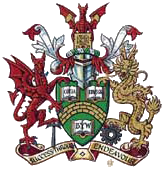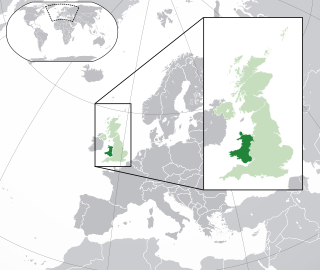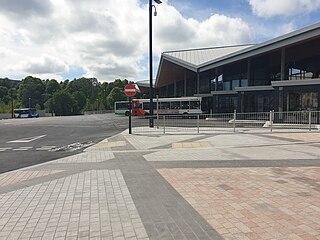Related Research Articles

Merthyr Tydfil is the main town in Merthyr Tydfil County Borough, Wales, administered by Merthyr Tydfil County Borough Council. It is about 23 miles (37 km) north of Cardiff. Often called just Merthyr, it is said to be named after Tydfil, daughter of King Brychan of Brycheiniog, who according to legend was slain at Merthyr by pagans about 480 CE. Merthyr generally means "martyr" in modern Welsh, but here closer to the Latin martyrium: a place of worship built over a martyr's relics. Similar place names in south Wales are Merthyr Cynog, Merthyr Dyfan and Merthyr Mawr.

The University of Glamorgan was a university based in South Wales prior to the merger with University of Wales, Newport, that formed the University of South Wales in April 2013. The university was based in Pontypridd, in Rhondda Cynon Taf, with campuses in Trefforest, Glyntaff, Merthyr Tydfil, Tyn y Wern and Cardiff. The university had four faculties, and was the only university in Wales which had no link with the University of Wales.

South Wales is a loosely defined region of Wales bordered by England to the east and mid Wales to the north. Generally considered to include the historic counties of Glamorgan and Monmouthshire, south Wales extends westwards to include Carmarthenshire and Pembrokeshire. In the western extent, from Swansea westwards, local people would probably recognise that they lived in both south Wales and west Wales. The Brecon Beacons National Park covers about a third of south Wales, containing Pen y Fan, the highest British mountain south of Cadair Idris in Snowdonia.

The Merthyr Rising, also referred to as the Merthyr Riots, of 1831 was the violent climax to many years of simmering unrest among the large working class population of Merthyr Tydfil in Wales and the surrounding area. The Rising marked the first times the red flag was used a symbol of working class rebellion in the United Kingdom.
Rugby league is a sport played in Wales. The governing body of the game in Wales is the Wales Rugby League.

The Diocese of Llandaff is an Anglican diocese that traces its roots to pre-Reformation times as heir of a Catholic bishopric. It is headed by the Bishop of Llandaff, whose seat is located at the Cathedral Church of Saint Peter and Saint Paul in Llandaff, a suburb of Cardiff. It currently covers most of the former Welsh county of Glamorgan, but once stretched from the River Towy to the middle of the Wye Valley.

Howard Winstone, MBE was a Welsh world champion boxer, born in Merthyr Tydfil, Wales. As an amateur, Winstone won the Amateur Boxing Association bantamweight title in 1958, and a Commonwealth Games Gold Medal at the 1958 British Empire and Commonwealth Games in Cardiff.

Merthyr Vale is a linear village and community in the Welsh county borough of Merthyr Tydfil. Lying on the A4054 road it is on the east bank of the River Taff.
Richard Lewis, known as Dic Penderyn, was a Welsh labourer and coal miner who lived in Merthyr Tydfil and was involved with the Merthyr Rising of 3 June 1831. In the course of the riot he was arrested alongside Lewis Lewis, one of the primary figures in the uprising, and charged with stabbing a soldier with a bayonet. The people of Merthyr Tydfil doubted his guilt, and signed a petition for his release. However, he was found guilty and hanged on 13 August 1831. After his death he was treated as a martyr in Merthyr and across Wales.
Merthyr Tydfil was a parliamentary constituency centred on the town of Merthyr Tydfil in Glamorgan. From 1832 to 1868 it returned one Member of Parliament (MP) to the House of Commons of the Parliament of the United Kingdom, and in 1868 this was increased to two members. The two-member constituency was abolished for the 1918 general election.

Edward Llewellyn Treharne was a Welsh rugby union forward who played club rugby for Pontypridd and Cardiff, and international rugby for Wales. He was a member of the first Wales international team that played England in 1881. At the time of the game he was still a student at Cowbridge, and later became a medical student at St Bartholomew's Hospital.

The history of the Jews in Wales begins in the 13th century. However, after the English conquest of Wales (1277–1283), Edward I issued the 1290 Edict of Expulsion expelling the Jews from England. From then until the formal return of the Jews to England in 1655, there is only one mention of Jews on Welsh soil.
Keith Pontin was a Welsh professional footballer who played as a central defender. Pontin began his career with Cardiff City, making nearly 200 league appearances and earning two caps for the Welsh national team.
Theophilus Aneurin Rees was a Welsh rugby union forward who represented Llandovery College at club level. He was capped once for Wales, in the country's very first international rugby match.

Michael Gustavius Payne is a Welsh figurative painter. He paints primarily in oils and is influenced by mythological themes within a contemporary context. During his early exhibiting career he was known as Michael Payne, before he began using his full name. Since late 2012 he has dropped his first name and now uses the shorter Gustavius Payne.

Mike Jenkins is a Welsh poet and fiction writer in English. He is also the father of the Plaid Cymru politician Bethan Sayed and of the journalist Ciaran Jenkins.

Park is a community and electoral ward of the county borough of Merthyr Tydfil, in Wales.

Merthyr Tydfil bus station is the bus station that serves the town of Merthyr Tydfil, South Wales.

Merthyr Tydfil County Borough is a county borough in the south-east of Wales. In 2022, it had an estimated population of 58,883, making it the smallest local authority in Wales by population. It is located in the historic county of Glamorgan and takes its name from the town with the same name. The county borough consists of the northern part of the Taff Valley and the smaller neighbouring Taff Bargoed Valley. It borders the counties of Rhondda Cynon Taf to the west, Caerphilly County Borough to the east, and Powys to the north.

The South Wales Metro is an integrated heavy rail, light rail and bus-based public transport services and systems network currently being developed in South East Wales around the hub of Cardiff Central railway station. The first phase was approved for development in October 2013. Works are currently under way, with a new depot under construction at Taff's Well and new trains being built by Stadler Rail in Switzerland. The development will also include the electrification of the core Valley Lines and new stations. All nine lines will be electrified, and the service was expected to be in operation by the end of 2024.
References
Academi (Welsh literature promotion)
Wales Arts International
British Council
Smith, Dai, Top 10 Welsh Alternatives to Dylan Thomas, The Guardian, 12/2/06